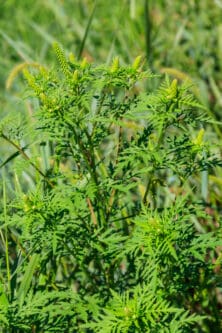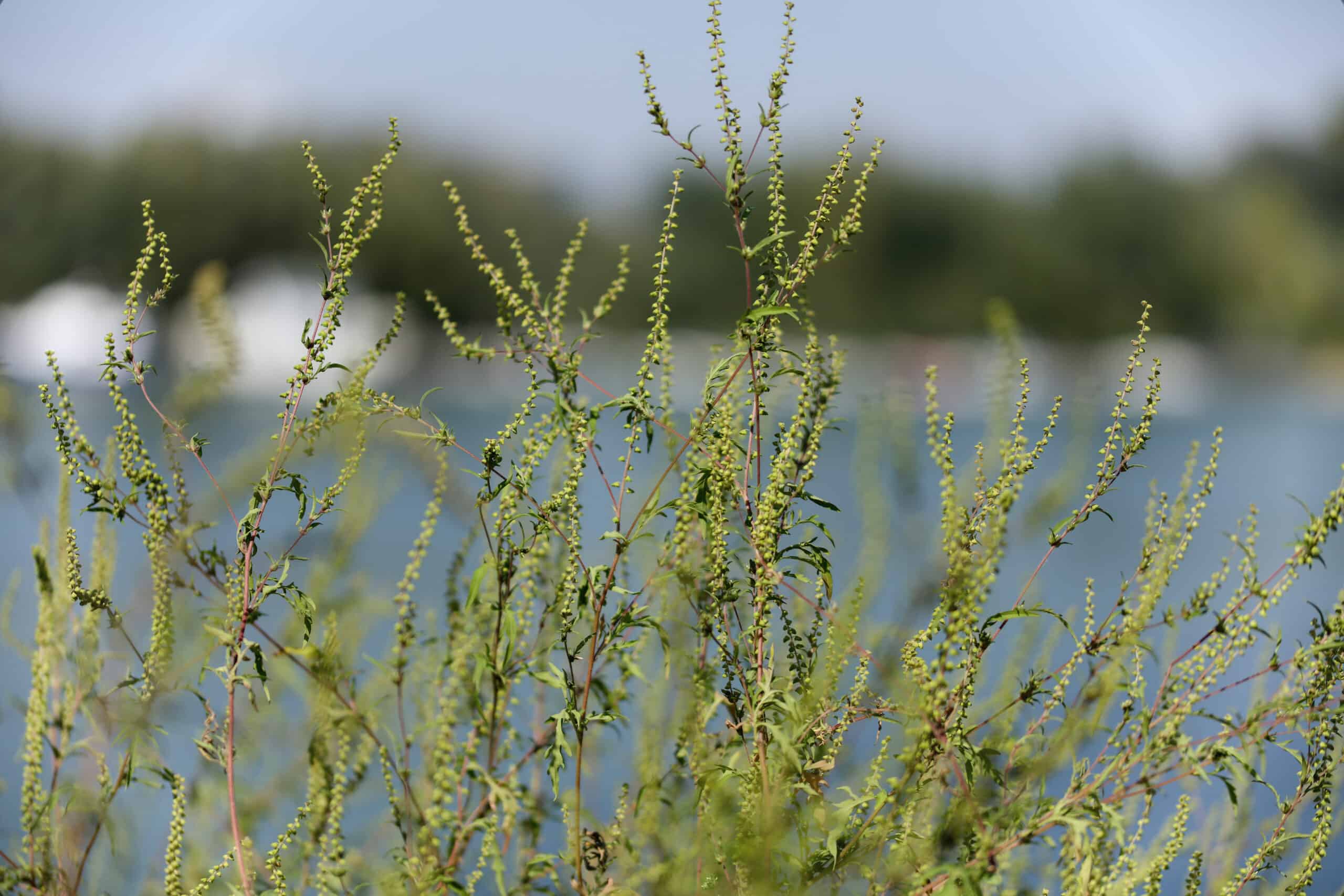In a previous blog, I described ragweed as one of the most notorious herbs known for causing severe allergies and, at the same time, taken internally to relieve allergy symptoms. I have since discovered that ragweed can be one of the most effective treatments for coughs caused by post nasal drip. Especially, the coughs that tend to linger for some time after other colds and flu symptoms have ended.
It’s common for people to associate coughs with bronchial infections. Naturally, our goal is to get rid of the mucus or tonify our immune system; we reach for cough remedies and immune strengthening formulas. If the mucus persists, many find themselves desperately seeking antihistamines, mucus-thinning medications or steroid nasal sprays; all of which have their side-effects. Yet this nagging cough fails to yield to these treatments.
This type of cough usually has thin, watery mucus which drips down into the back of our throat from the nose and collects in the upper respiratory tract. In many cases, I have found ragweed, aka ambrosia, tincture to be effective for stopping the leak of mucus from the nose to the throat; stopping the cough sometimes within 20 to 30 minutes thereafter. On the average, only 15 drops of ragweed tincture (1:5, 40%) can be taken 2 or 3 times a day to quell these types of coughs. Ragweed tincture is effective for coughs associated with symptoms of allergic rhinitis, cold and flu.

Ragweed: Safe and Highly Effective
Ragweed could be thought of as nature’s safe and highly effective antihistamine herb; without the drowsiness and occasional dizziness associated with over the counter (OTC) drugs used to treat colds, flus and allergies. These products sold at pharmacies include Mucinex, Allertec, Zyrtec, Benadryl, Flonase, Tylenol and Ibuprofen. All have both short-term and long-term side effects that can even prolong the allergic rhinitis, cold and flu, and cough.
Mucinex (Guaifenesin) is a popular allergy medication that may help thin mucus so that it can be expectorated from your lungs. Its side effects include dizziness and headaches.
Tylenol (Acetaminophen) and Advil (Ibuprofen) are used to relieve headaches including those associated with colds and flus. These have mild to serious gastro-intestinal side effects, including liver damage.
Flonase is a popular nasal steroid that treats allergies. If used regularly it will thin the mucus membranes; increasing sensitivity to pollen, pet dander, dust mites or ragweed; which in the long term results in more, rather than less, mucus formation.
The point being, common ragweed tincture has none of these side effects. The one thing it has in common with all of these OTC drugs is that they are all palliative not curative. Any hopes of achieving a curative outcome will have to consider one’s lifestyle and eating and drinking habits. In the meantime, anyone afflicted with allergies, drippy nose, itchy eyes, throat and cough will appreciate relief from these symptoms whether or not they choose to work on a long term cure. Keep in mind that even Traditional Chinese Medicine considers phlegm as one of the most difficult conditions to resolve.
Herbalists tend to focus on the use of immune tonics and immune stimulants for symptoms associated with allergic rhinitis. Which can theoretically increase the autoimmune response that causes hypersensitivity to the various allergens that cause allergies.
Many immune tonic herbs, such as astragalus, are amphoteric in that they tend to up or down regulate the immune response; including the tendency to produce mucus on an as necessary basis. Because astragalus has a warm and stimulating energy, it is not my first choice for treating an active histaminic response which includes symptoms of post-nasal drip.
This is where ragweed tincture can be uniquely useful. Its use corresponds to the homeopathic dictum which asserts that ‘like cures like.’ Meaning a substance that causes an adverse reaction such as pollen, pet dander, dust mites and ragweed can, perhaps not always, be effective for treating the symptoms it causes. The efficacy of ragweed extract for allergies is well known with documented research.
This offers the possibility of adding ragweed as a safe herb with none of the adverse effects associated with the various commonly available OTC drugs described previously. Since there are many causes for coughs and ragweed requires only a minimum dose, I recommend adding ragweed tincture as part of any cough regimen one may employ.
Thomas Avery Garran offers a marvelous monograph in his book Western Herbs in Chinese Medicine stating, “Ambrosia is used for sinus congestion due to external wind invasion.” This pattern can lead to sinus congestion, which includes post nasal drip, for which this herb is a specific. He also says that it “…transforms phlegm and calms panting. Ambrosia is used for wheezing and panting with hasty breathing, difficulty taking full breaths, anxiety and even panic.” Here he is describing allergic asthma. Thomas is one of my greatest students and his books on the use of Western herbs in Chinese medicine are the best, even surpassing my own attempts on the subject.

Ambrosia; A Weed for Harvest
Ragweed (Ambrosia artemisiifolia), a plant native to the Americas and commonly disseminated throughout the world, is a notoriously hyperallergic plant. One plant distributes literally billions of fine, windborne pollen grains for a distance of 100’s of miles causing miserable respiratory allergies to millions.
So far as I can tell, I have not found any ambrosia in the vicinity where I live. Because I have found it to be medicinally valuable, I don’t want to be the well-intentioned herbalist to introduce a plague by planting it in my herb garden. Besides, many have enough to contend with similar airborne pollens from springtime acacia trees, native to Africa, once introduced as an ornamental in our region.
If one happens to live in a place where ragweed is abundant, one can easily make their own ragweed tincture. Simply fill a small jar with freshly cut or dried ragweed flowering tops and pour vodka over it to cover. This should stand for several days to 2 weeks before press-straining through a white cotton cloth. The liquid is the finished extract and the mark (herb material) can simply be discarded. If so desired, one can make a stronger extract by adding more ragweed to the extract.
I’ve not been able to discover why the second Latin binomial used to identify ragweed is ‘ambrosia,’ which in Greek refers to “foods and herbs that bestow health and longevity.” However, few people probably realize its paradoxically unique healing properties. It is one of those cases where that which can cause harm is also that which heals. It so happens that ragweed, aka ambrosia, is one of the most effective herbs with antihistamine properties and, unlike pharmaceutical antihistamine products, has none of the well-known side effects associated with drugs.
Again, I caution against introducing ragweed in your garden to protect others from developing allergies. However, there are many areas in the country where ragweed is already abundant and from where the herb can be obtained. One can also purchase a ragweed extract in stores that sell herbal products or online.


Thank you for this interesting writing, I would never have thought of ragweed this way.